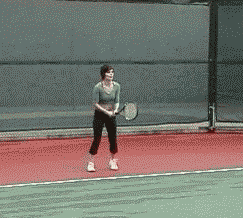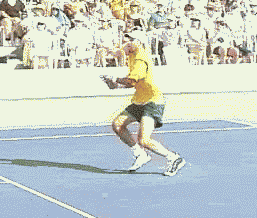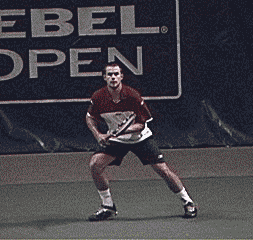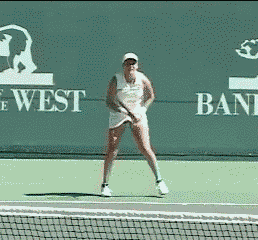|
TennisOne Lessons Avoiding Common Mistakes in Tennis Groundstrokes Dave Smith TennisOne Senior Editor
The problem with many of these common stroke errors is that they are either associated with comfort or with misinformation—or, in some cases, they are associated with the wrong perception of the right information. However the stroke errors were established, being able to clearly recognize the problem is the first step to rectifying the undesirable pattern. The second step is using tools to prevent the problem from reoccurring. It is this recognition and subsequent prescribed remedies for such problems that I will attempt to convey in this article. Groundstroke Problems What are some of the tell-tale signs of groundstroke problems?
These four groundstroke problems can be boiled down to one generalized problem: Inability to maintain a congruent racquet face throughout the swing. (Or, more specifically, within the contact phase of the stroke.) Rolling the Racquet Rolling the racquet is the most common problem for beginners and intermediate players. The concept of topspin is fairly well understood. What is misunderstood is how we manufacture topspin within tennis strokes. It isn't so much a misunderstanding…as much as it is our body's false sense of how it thinks topspin is manufactured. Rolling the racquet is the act of turning the racquet plane from open to closed within the course of the contact zone. It isn't a wrist movement; it is actually the pronation of the forearm. (The rotation of the radius bone over the ulna.) Another way to think of it is to hold your palm up and rotate it to palm down as you simulate a forehand swing of the arm. There seems to be a human quality that comprehends topspin as the racquet rolling over the ball, almost like stroking a cat or a dog's fur in reverse. (Try this: imagine a cat on your lap and you are going to pet the animal with your dominant hand. Your hand will naturally curve over and down the imaginary back of the cat. While you can ‘brush' a pet's fur in such a fashion, rolling the racquet over a ball does not make the strings brush up the back of the ball.)
Unfortunately, when we roll the racquet in such a fashion, the hitting surface of the strings is constantly changing. And, since the ball is only on the strings for a fraction of a second, such change of the contact surface requires perfect timing on the part of the player to direct the ball with any precision. At higher speeds, this perfection in the timing department becomes exponentially more critical when a racquet rolls at contact. It seldom adds up to much topspin. However, it feels like it should! It is with this false perception that individuals have difficulty in preventing this rolling action from happening. When a player rolls the racquet at contact and they are a fraction early on the swing, the ball will go into the net. A moment late, the ball sails long. Such imperfection requires a much slower swing to allow for both the timing issue and the resultant differentiation in expected shot direction! Such patterns of hitting tennis balls leads directly to ‘dinking'! (And that is another topic altogether!) Type of Racquet Rolling It is interesting to analyze the difference in rolling the racquet on topspin versus rolling a racquet under the ball as in hitting a slice. The topspin roll not only changes the racquet face from open to closed, it can change 90 degrees or more. However, if we slice (or undercut) the ball with a rolling racquet face, the racquet goes from open to more open and the degree of change is seldom more than 30 degrees. This explains several observations.
Keep the Plane the SameOne of my favorite and most useful phrases I have coined over the years is, "keep the plane the same." It describes our goal of hitting more consistent topspin and slice strokes. If you want to apply topspin to the ball, instead of rolling the racquet, ‘brush' up the back of the ball with little or no variance in the hitting surface. The more significant the upward movement of the brush, the more topspin will be applied.
There are many variables that will affect this spin: The amount of spin of the ball that is bouncing up towards us; the speed and angle of the ball's bounce; whether the ball is being hit as it is rising towards us (hitting the ball on the rise, as we say), or whether it is arching downward before we hit it; how much forward movement of our racquet is combining with it's upward movements, and so on. Regardless of the grip we choose, this principle, (keep the plane the same) is critical to increased consistency as well as the ability to eventually hit with greater pace and power (And still retain control!). Effect on Aiming Rolling the racquet will reduce your ability to improve your aim as you practice. Here is an example: If I hit twenty balls in a row, and with each stroke I roll the racquet through at contact, I won't know where to aim on each successive shot. This is because the rolling effect will change the direction based on the timing of contact; too early the ball goes low…too late, the ball goes high. If I aim higher on a ball that I ended up hitting early, and subsequently hit this shot a fraction late, the ball will go too high and way out! However, if I keep the racquet face the same during each swing, I can indeed aim according to the previous shot because the racquet face is NOT changing on subsequent strokes. This is how skilled players can obtain nearly pinpoint accuracy using the correct technique! Wrist Swings The second prevalent problem in producing skilled groundstrokes is the use of the wrist in hitting the ball. Wrist action is often a result of players having played wrist-intensive sports. (Such sports usually include racquetball, badminton, squash, and sometimes golf.) A swing using the wrist causes the racquet not to roll, but to ‘flick'…much like how a fishtail moves back and forth. The result of this move is similar to that of the racquet roll; the racquet face changes drastically during contact and through the stroke. However, the loss of directional control is related to left and right aim rather than up and down as with the roll. Typically, the wrist swing originates from a hesitant swing. The player is not confident so they take almost no backswing. However, unlike the volley which is hit with not only a short backswing, but also a short blocking motion (in most cases), on groundstrokes, this short backswing does not allow for any acceleration of the racquet prior to contact. Thus, the player flicks the racquet at the ball using the wrist.
Solutions If we know we are using the wrist or rolling our racquet during our swing, there are some tools that you can use to help learn how to prevent these two tendencies.Two-handed Swing While I have been a proponent of two-handed swing patterns for both the backhand and the forehand, players who find they are using wrist or rolling the racquet can find it difficult to feel what the racquet is doing. Using a two-handed swing can help the player both feel what the hands are doing as well as provide stability during the stroke. The use of two-hands in this case is a practice tool, not necessarily a complete overhaul of the stroke. (Although many might discover success in the practice and eventual enjoyment of two-handed swings.) For advice on the two-handed forehand, see my two articles on the two-handed forehand. For the two-handed backhand review Heath Water's “Make Your Backhand Your Strength” as well as Jim McLennan's “Agassi: The Best Two-handed Backhand in the Game.” The reason two-handed swing patterns work so well in terms of learning is that they are different enough that the player won't go back to their old methods. Yet, they can contribute to learning a congruent swing path that is essential for developing consistent and effective groundstrokes.
Videotape Using videotape provides clear feedback to what a player is really doing. While some players actually think they are doing one thing, the videotape can reveal something quite different. Using the TennisOne ProStrokes Gallery, you can compare your techniques to that of the pros. Also, I might recommend a side-by-side comparison model which can show you clearly what you are doing at the very moment the pros are doing it. Conclusion If you discover what you are doing wrong, then you will be in a better position to address those issues and perhaps make the appropriate adjustments. These two examples of common mistakes are very prevalent in many recreational and club level players. One of the problems is the fact that most have varying degrees of both problems…enough to keep them from making significant strides towards higher-level tennis. Make sure you are keeping these mistakes to a minimum and you will be on your way to more effective and consistent shot making! Your comments are welcome. Let us know what you think about Dave Smith's article by emailing us here at TennisOne .
TENNIS MASTERYFinally. a resource that unlocks these mysteries: • Why do m • Why are making changes in one's game so frustratingly difficult? • What tennis teaching methods are disruptive or detrimental to player progression? Read David W. Smith's TENNIS MASTERY and learn not just how to avoid playing at mediocre levels, but how the best players in the world Master the sport of tennis! "With a depth of knowledge and fresh perspective, TENNIS MASTERY is set to become a manual for tennis instructors and a measure for tennis literature." Richard Wigley, Director, Kayenta Tennis Center , Ivins Utah . Take in David Smith's 30 plus years in the tennis teaching industry. This 335-page manual will provide for every level of player as well as support for all tennis-teaching professionals, a blueprint for reaching higher levels of tennis mastery. Order TENNIS MASTERY at tenniswarehouse.com , or go to tennismastery.net for exciting excerpts from the book and a host of tennis information! And check out David Smith's other articles found here at TennisONE.com David has taught over 3000 players including many top national and world ranked players. He can be reached at acrpres1@email.msn.com. |






 illions of tennis players stagnate at levels far below their potential?
illions of tennis players stagnate at levels far below their potential?  Your comments are welcome. Let us know what you think about this article by
Your comments are welcome. Let us know what you think about this article by